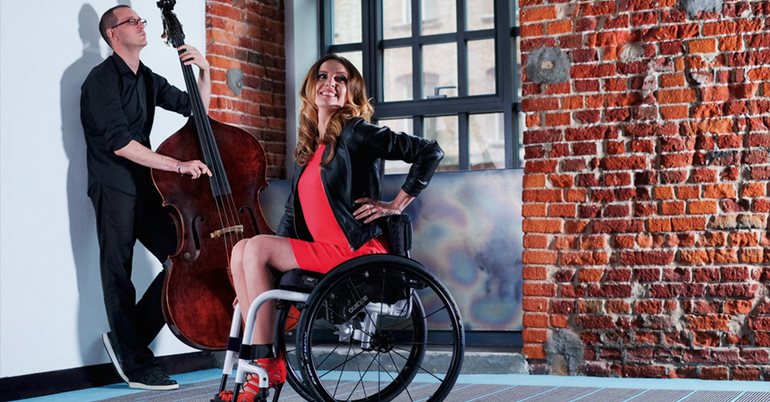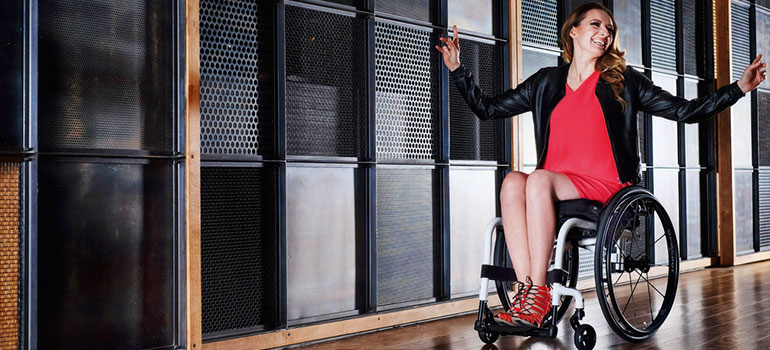Dancing has many benefits, both physical and psychological. It helps individuals to keep active, controls functions such as cholesterol, channels energy & emotion, strengthens the heart, and it's also a great natural antidote against osteoporosis and stress. In other words, dancing can help us to keep fit and raise our self-esteem.
These benefits can be enjoyed by anyone who practices dancing, regardless of age, gender, or physical condition. However, in this article, we want to focus primarily on the benefits of wheelchair dancing and the different styles of this healthy, enjoyable, and unifying sport.

What are the benefits of wheelchair dancing?
Generally speaking, all sports are beneficial for people with disabilities. Dancing is a corporeal and emotional discipline with numerous therapeutic benefits for people with physical, sensory, or learning disabilities. Some of the benefits of wheelchair dancing include:
It helps us to get to know our bodies better
Being aware of specific movements and postures helps us to understand our bodies better and the limits we can place on them, which is key to overcoming our physical barriers and improving our mobility. On a psychological level, being aware of our body and its abilities is also very positive, especially for helping us to learn to accept ourselves for who we are and express our emotions.
Keeping healthy and active is a win-win situation
The physical exertions involved in dancing are beneficial for us and can help to strengthen our hearts and increase our lung capacity, which is why the American Heart Association recommends dancing as an aerobic exercise to reduce the risk of heart disease.
Another benefit of wheelchair dancing is that on a physical level, it can act as a "substitute" for going to the gym to lose weight: an hour of dancing can burn between 200 and 400 calories, a figure similar to cycling or running. Also like other aerobic sports, wheelchair dancing can help us to lower our cholesterol.
Improves postural hygiene, coordination, and memory
Sedentary daily routines and lack of exercise can often lead to the adoption of poor postures in the wheelchair, which can result in more serious ailments such as back, arm, and neck pain. One of the great benefits of wheelchair dancing is that we can easily correct these poor postures while relieving stress in the joints & lower back and strengthening our bones & muscles.
Additionally, learning choreographed moves, either individually or in a group setting, can help to improve coordination. Furthermore, when learning dance routines (steps, movements, interactions with partners, etc.), we can also improve our memory and increase our ability to perform several tasks at the same time.

Raises our self-esteem and reduces stress
Like other creative activities, dancing allows us to express ourselves on a physical level, which stimulates the production of endorphins and conquers stress levels. It also helps to regulate our serotonin and dopamine levels, which are key neurotransmitters that regulate our mood. Consequently, dancing can help us to maintain a more positive, cheerful, and enthusiastic attitude in our daily lives.
Dancing can help us to get on better with one another
Another benefit of wheelchair dancing and dance in general, is its ability to promote interaction. As we have previously mentioned in some of our other blog articles, the practice of group sports promotes social inclusion and helps to establish and strengthen social relations.
However, that's not all. Thanks to the movements and contact involved, dance can serve to help us communicate better with others by turning our body into a vehicle that can transmit our life history and experiences, which is precisely the objective of inclusive dance, in which people with and without disabilities share the stage. This activity, which some companies develop specifically, turns the dance floor into a type of shared living space.
Although wheelchair dancing is usually performed in groups or by couples, it can also be used as individual therapy, since the techniques and styles adapt to each person individually.
Wheelchair Dancing As an Adaptive Sport
In addition to the obvious benefits of wheelchair dancing as a leisure activity, for many people dancing is a competitive sport. In fact, since 1998, wheelchair dancing has become famous throughout the world and is recognized by the International Paralympic Committee, the World Federation of Sports Dance, and also the Wheelchair Dance Sport Association UK.
There are currently four major wheelchair dance categories adapted to competition level:
- Duo. When both dance partners use wheelchairs.
- Combined or mixed. When one part of the couple uses a wheelchair, and the other does not.
- Formation (or groups). One of the peculiarities of wheelchair dancing is that group dancing can involved participants both with and without wheelchairs. In total, four to either couples will take part.
- Individual. This category applies to single wheelchair dancers.
The different styles involved in wheelchair dance championships are practically the same as general unadapted dance categories.
- Standard dance style. Includes the "classic" dance styles like the waltz, the Viennese waltz, and foxtrot slow, tango, or quickstep.
- Latin dance style. Includes the salsa, rumba, chachachá, or pasodoble.
- Free style. Includes the most "free" contemporary styles, such as hip-hop, folk music or streetdance, in addition to contemporary dance, ballet, and all those styles not included in the first category, such as cumbia or belly dancing.
Would you try wheelchair dancing?
As discussed, there are a whole host of benefits of wheelchair dancing, both physically and psychologically. So, if you like dancing, why not give wheelchair dancing a whirl?
This activity can be carried out by people in wheelchairs, but also by people with sensory disabilities (for example, vision and hearing problems), people with psychological disabilities, and other groups with mobility or learning difficulties.
In all cases, dancing increases your rhythm, coordination, balance & flexibility, and helps to develop your ability to interact, express yourself, and integrate.
There are many dance schools where you can try for yourself and enjoy the many benefits of wheelchair dancing. Enjoyment is practically guaranteed.
Most of the stories here on LiveQuickie.com were submitted by readers. Do you have a story to tell? We'd love to hear it. Submit your story here.